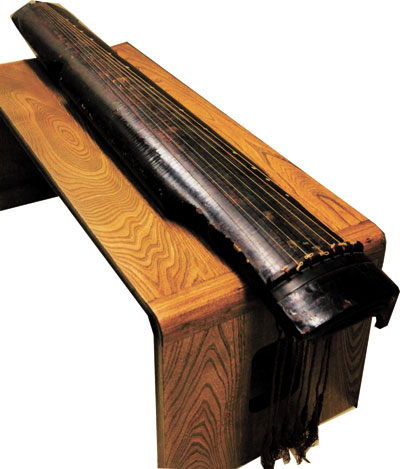
Wang Yuanyuan
cheekywang@hotmail.com
A TOTAL of 43 ancient guqins, mostly from Sichuan and Chongqing areas, are now being exhibited at the New Shenzhen Museum in Futian District until Oct. 7.
Guqin is a seven-string zither without bridges, the most classical Chinese musical instrument with more than 300 years of history. It is literally called “qin” and commonly known as “guqin” (gu means “ancient” in Chinese).
Guqini has a well-documented history and the best preserved repertoire among all Chinese instruments. Learning guqin used to be regarded as a very important part of education with the purpose of enriching one’s heart and elevating the human spirit.
In ancient China, guqin represents one’s values and one’s attitude to the society and the people. Because of its great importance for the upper class in the country, collecting exquisite guqin became their great hobby, which promoted the development of guqin-making techniques. They were not just a wooden piece with strings but a canvas to display elegant calligraphy, painting and sculpture arts.
When guqin was invented is unknown, but it is mentioned in several of China’s oldest written documents such as “The Book of Songs (“Shijing”), and “Collection of Ancient Texts” (“Shangshu”).
During the Spring and Autumn (770-476 B.C.) and the Warring States (475-221 B.C.) periods, it became an independent musical instrument for soloists. Several well-known works, such as “High Mountain,” “Flowing Water” and “White Snow” were written at that time. A 10-string guqin found in Hubei Province has a history of more than 2,500 years and is the oldest guqin ever found in China.
Guqin was mainly used for grand events and religious ceremonies in the beginning, but in the Han Dynasty (206 B.C.-A.D. 220), it drew favor with scholars and the highest class in society. In the Sui (581-618) and Tang (618-907) dynasties, it gradually became a representative of Confucianism and Taoism, representing Chinese scholars’ spiritual pursuits of “justice,” “nature” and “benevolence.”
Being top of the four traditional arts, the guqin is seen as one of the most important symbols of Chinese high culture. Unfortunately, only a small number of people in ancient China could play the instrument because classical musical education of this kind never reached the general public. The situation today has not improved. Due to this, a lot of ancient music was lost through time.
In 2003, guqin was registered as one of the masterpieces of the oral and intangible heritage by the UNESCO.
Sichuan and Chongqing have the largest number of guqin among other areas in China because of their special roles in guqin history, said Tang Yin, a researcher from the Three Gorges Museum who lend 23 guqins for this exhibition.
According to ancient documents, Sichuan Province has always been a leading area for making guqin in ancient China. Among them, a Sichuan family surnamed Lei were the best technicians for making guqin since the Tang Dynasty and have produced a large number of the greatest Lei-style guqin over generations. At present, the two most valuable and well-known guqins collected at the Palace Museum in Beijing were both made by the Lei family. Because of the area’s achievements in guqin making, a lot of ancient guqins were found in the area.
The guqins at this exhibition are from the Tang to Qing (1644-1911) dynasties. Although many of them could not be played now, they still have great value for art and historic study.
Among them, a guqin called “Shijianqiaobing” (Knocking on ice between stones) made in the Tang Dynasty is one of the most famous. The purple-color guqin is about 122.7 centimeters long and 17.5 centimeters wide. It has very high artistic value and is an important piece for studying ancient guqin.
Another must-see item is a guqin called “Songshijianyi” (Learning the meaning between pine trees and stones) made in the Song Dynasty (960-1279). The guqin had the largest number of scripts carved on the body. Most of the scripts were carved by well-known scholars and poets in the Song, Ming (1368-1644) and Qing dynasties such as Su Dongpo, Tang Bohu, Zhu Yunming, Wang Chou, Wen Peng and Chen Tinglu.
|

